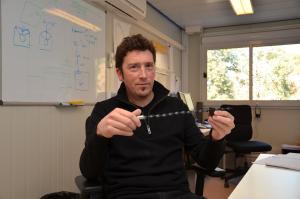Welcome, Mr. Tungsten Divertor
What do you expect to talk about when you plan for an interview with the newly appointed leader of the Tungsten Divertor Section? Tungsten? The tungsten divertor ? As if it were that easy ...
On 1 January of this year Frederic Escourbiac took over the Divertor Section from Mario Merola, who is now in charge of ITER's Internal Components Division. Frederic inherited a well-run house: four signed Procurement Arrangements, including those for the carbon fibre-reinforced carbon composite (CFC) targets facing the extreme heat at the very bottom of the ITER machine; the quality assurance program for all participating parties accomplished; and the preparation for the prototype manufacturing well under way. But then the "tungsten bomb" hit us, Frederic says, not sure if these words are politically correct. "But that was very much what we felt."
Driven by the urgent need to bring the project's costs down, the ITER management last summer launched an investigation into whether it was feasible to abandon the original carbon phase of the divertor and to implement tungsten right from the beginning of operations. The savings for the one-track-tungsten option would be in the range of EUR 400 million, as estimated by the procuring party, Europe. It was thus decided by the recent ITER Council, following the advice of the scientific and the management advisory boards, to delay the final decision on the specific choice of the divertor targets for up to two years and, in the meantime, focus the research and design activities on the tungsten option.
The soon-after rebaptized Tungsten Divertor Section took a pragmatic approach to the modified boundary conditions: first, they met in the nearby village of Vinon-sur-Verdon where they symbolically buried the carbon divertor, then they went back to the design codes and standards and drawing stations and faced the new challenge. And the full tungsten divertor is an engineering challenge, as Frederic explains. "Tungsten has the big advantage that it doesn't absorb tritium as compared to carbon. But at the same time, it does not offer the same forgiving behavior of carbon."
The stakes are thus high for Frederic and his team, but the engineer from the University of Toulouse, in his home town, is confident that they will develop a viable solution. And looking at his education, he has all the tools he needs at hand: his professional career started in 1995 at the IRFM, the fusion branch of the CEA in Cadarache that operates the French Tore Supra Tokamak. Within the framework of the CIEL (Inner Components and Limiter) project, he participated in the upgrade of all the internal components of Tore Supra.
Soon after, he became deputy section leader of the Plasma Facing Component Group. A job that prepared him well for his next move to another job which eventually lead him to the component at the very core of the ITER machine, the divertor.
In order to coordinate design development a Tungsten Divertor Task Force has been established, lead by Takeshi Hirai, responsible officer for the divertor outer vertical target procurement within the Japanese Domestic Agency. The kick-off meeting for this Task Force is planned to take place 3 February. It will be helpful to come to a decision about which road to follow within the next two years: go for tungsten right from the start or start with CFC . "My concern is not the outcome of this decision," says Frederic. "It is more the question when to draw the line, when to make that choice. That will be the hardest decision I see ahead."


